Call: 01635 741 541 ![]() Call me back
Call me back
Call: 01635 741 541 ![]() Call me back
Call me back
Any solar array is a substantial investment and a valuable asset with a lengthy operating lifespan. To justify the capital investment and realise the forecast return on investment, it's crucial that the array performs at maximum operating effectiveness throughout its service life. Like any engineered solution, this necessitates regular cleaning and maintenance.
Solar Panels are not self-cleaning contrary to popular belief. Whilst wind and rain may wash away surface debris, residual build of environmental and atmospheric contaminants occurs on any solar array. These residues create a rough surface which captures dust and retains moisture, providing the ideal conditions for algae and lichen to form. In coastal areas, sea salt residues and gul fouling compound this issue. This can cause hard shading and etching which can cause permanent damage to the performance of the array and invalidate manufacturer warranties.
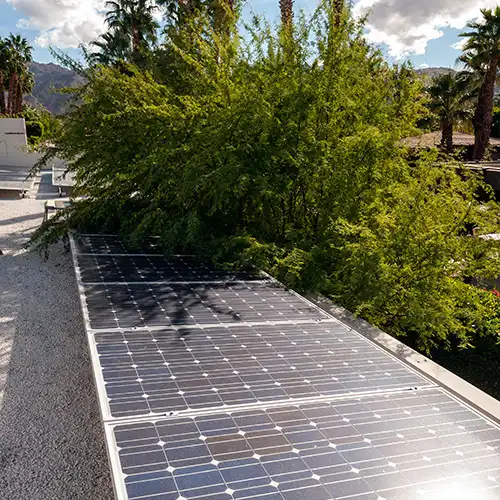
Hard shading or PID (Potential Induced Degradation) can cause damage to solar panels under certain circumstances. When light is permanently shaded or blocked from a panel or cell, it can lead to a phenomenon called "hot spotting." Hot spotting occurs when shaded cells within a solar panel absorb less sunlight than unshaded cells, leading to an imbalance in electrical current. This imbalance can cause the shaded cells to become reverse-biased, essentially acting as resistors and dissipating energy in the form of heat.
The excessive heat generated by hot spotting can damage the shaded cells and adjacent components reducing efficiency and design life. Hot spotting damage may be so severe it requires premature and costly replacement of panels. Hard shading will also cause a reduction in energy production and efficiency across the entire solar string. Shading on one panel can affect the output of the entire string or array. This impacts the overall performance and profitability of the solar installation.
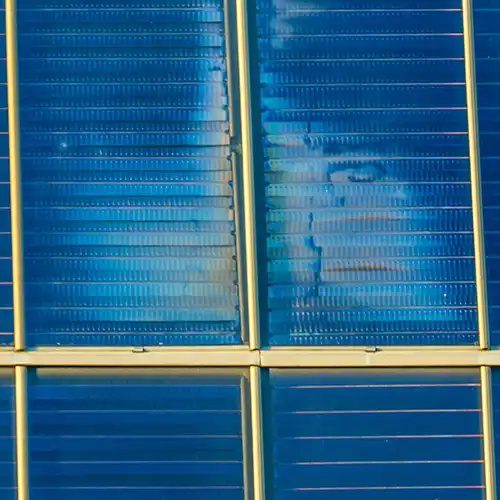
Localised areas on solar arrays where excessive heat is generated will go brown on either the top side or underside of panels, often resulting in brown or dark discolouration. These hot spots can occur for various reasons and may indicate underlying issues with the solar string or complete array.
To mitigate the risk of brown hot spots it's essential to address root issues such as hard shading, mismatched cells, or faulty bypass diodes. Integral within our cleaning and maintenance services, we proactively inspect panels and can help identify and rectify potential problems before they escalate. We provide an Infrared scanning service to identify hot spotting and potential browning occurring before it becomes visually apparent. This provides another example of why preventative maintenance is so important in protecting your solar asset and return on investment.
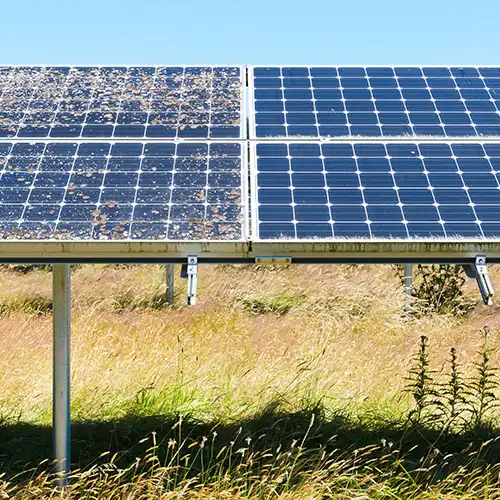
The consistently damp conditions across the UK provide the ideal conditions for algae to form on arrays and lichen to subsequently form in symbiosis. Whilst we can safely remove lichen growth from solar assets, it must be avoided. Setting aside the issue of hard shading and performance degradation, lichen removal is time-consuming and requires specialist treatment increasing operational and maintenance costs. Annualised cleaning using environmentally friendly and panel manufacturer-approved preventative treatments will prevent lichen growth and is the key reason we recommend preventative cleansing and maintenance.

Bird fouling on solar panels can be a significant issue, particularly in areas where bird populations are high. Bird droppings accumulating on the surface of the panels reduce their efficiency and impact energy production by hard shading and etching. Acidic compounds in the droppings can corrode the surface of the solar panels. This can lead to permanent damage to the protective coatings and materials of the panels, compromising their longevity, effectiveness and warranty.
Accumulated bird droppings on solar panels can create safety hazards, such as slippery surfaces for maintenance personnel. In addition, bird droppings contain bacteria and other pathogens posing health risks to individuals who come into contact with them.
Bird fouling can detract from the aesthetic appearance of solar panels, particularly in residential or commercial settings where visual appeal is important. This can impact property values and the overall perception of the solar array.
The good news is bird fouling on solar panels can be deterred by installing proofing systems such as mesh screens, spikes, visual deterrents or netting to prevent birds from landing and roosting on the panels. We complete proofing projects frequently in conjunction with cleansing maintenance programs and have successfully eliminated heavy bird fouling on a wide range of residential and commercial solar assets.
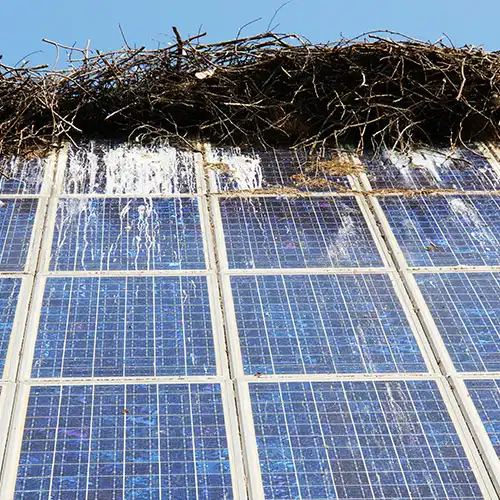
Birds will perch on or nest under solar panels leading to issues such as hard shading, debris accumulation and potential panel and property damage. Bird proofing measures include installing spikes, nets, wire mesh and static visual deterrents.
We have extensive practical knowledge of bird and rodent proofing systems delivered in conjunction with our sister company ADS Integrated Pest Management.
Further information is available here.

Delamination in solar panels is the separation of structural and functional layers within the panel, typically occurring between the glass cover, the solar cells and the backing panel. Delamination is a significant concern as it can compromise the structural integrity and performance of the panel. You must never use a pressure washer on your solar array as this may cause delamination and moisture ingress.
Inspection of a solar array prior to cleaning will identify delamination and its possible cause.
Regular cleansing inspections can help identify any signs of delamination early on, allowing for timely repairs or replacements to be installed.
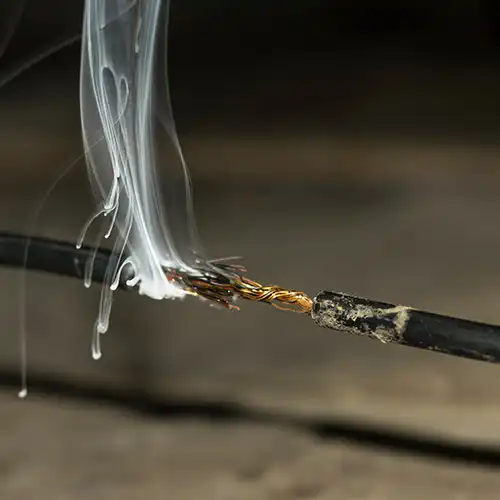
This damage can occur due to various factors and can have significant implications for the performance, safety, and longevity of the solar installation.
Common causes and implications of solar array cable damage are:
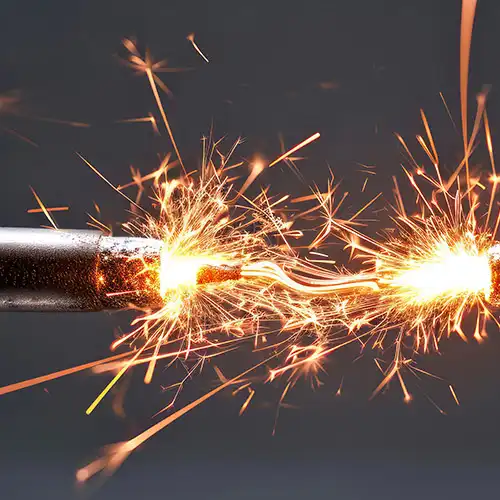
Electrical arcing can occur within the MC4 connectors used to connect solar panels. This can lead to a variety of issues, including reduced energy production, damage to the connectors, overloading and serious health & safety issues.
One of the most common causes of arcing in MC4 connectors is loose connections between the male and female connectors. Loose connections can create gaps between the contacts, leading to arcing as electricity jumps across the air space. This will leave telltale scarring on the connector and can be seen if accessible.
Proactive maintenance and cleansing will assist in identifying loose connections, corrosion, overloading, rodent damage and other potential issues, the risk of arcing in MC4 connectors can be reduced to ensure the safe and efficient operation of your solar array.

A "solar siphon" is a specialised drainage clip designed for solar arrays installed at a low pitch. These simple drainage accessories are typically used to prevent water and debris accumulation against the metal frame on the lower edge of a panel where the shallow pitch does not allow for all surface water to run off.
The clips are designed to create a siphon effect, where dirty water and suspended contaminates are drawn away from the lower edge of the panels and discharged on the surface below or into a guttering system. This helps to remove dirty water from pooling and stagnating on the panel reducing algae/lichen growth and delamination. We retrospectively fit Solar Siphons as an additional service following cleaning to extend cleaning frequency intervals.

Solar panel overheating can occur when the panels absorb more sunlight and heat than they can dissipate, leading to a rise in temperature beyond the optimal operating range. There are contributing factors beyond direct sunlight including poor airflow around the array due to vegetation, structures or debris, shading, and dust and debris.
By taking proactive measures to address the causes of panel overheating, system owners can ensure optimal performance, longevity, and safety of their solar assets with a preventative maintenance service.